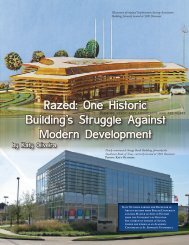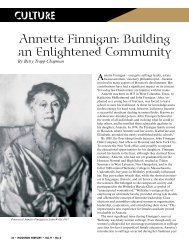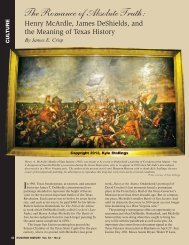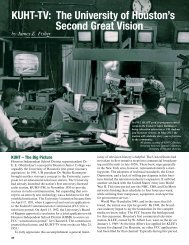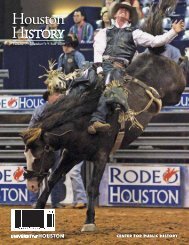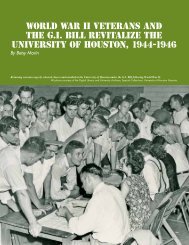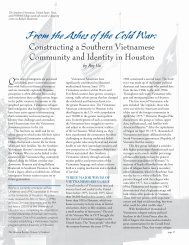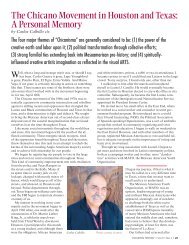A large crowd gathered for the much-anticipated opening of Sharpstown Mall on September 14, 1961.Photo Courtesy of the <strong>Houston</strong> Metropolitan Research Center, <strong>Houston</strong> Public Library, <strong>Houston</strong>, Texas.The area around the intersection of Bellaire Boulevard and GessnerRoad became the city’s suburban Chinatown. Photo by author.centers and service-sector businesses owned by Central Americanssprang up in the area. In addition, Asian-owned mini-mallsand strip commercial developments and redevelopments dominatedcertain neighborhoods. The area around Bellaire Boulevardand Gessner quickly became the city’s “suburban” Chinatown.In most cases, the newcomers recycled “Anglo” buildingsleft vacant during the oil bust. Many of the entrance signs atgrocery stores, local markets, shopping centers, and businessesbegan to appear in multiple languages, including English, Spanish,Vietnamese, Arabic, and Korean. By repurposing these42 Vol. 6, No. 3–Sportsstructures, minorities actively reshaped their environment, themarket, and community within Sharpstown. 11Between 1955 and 1990, the population of Sharpstownincreased from a few hundred to close to sixty thousand. Duringthis period, Hispanics made up the fastest-growing segmentof the population in Sharpstown and other demographicallysimilarneighborhoods of southwest <strong>Houston</strong>, including Alief,Gulfton, and Westwood. Significant numbers of blacks andrecent immigrants from Asia flooded the once racially-uniformneighborhood and mixed with Anglos and Hispanics. 12 Thecommunity continued to diversify, and by 2000, the totalpopulation reached over 77,000. While the community sawsignificant gains in the number of minorities between 1990 and2000, the percent of non-Hispanic whites in the neighborhoodmarkedly decreased. By 2000, Anglos comprised just twentypercent of the population, African America ns made up seventeenpercent, and Sharpstown’s largest ethnic community,Hispanics, comprised nearly half of the population at forty-sixpercent. Sharpstown’s Asian community witnessed significantgains in population and, according to the Sharpstown CivicAssociation, “economic strength,” resulting in the formation ofthe Asian Chamber of Commerce, “a vibrant and growing forcefor business in Sharpstown and Southwest <strong>Houston</strong>.” In fact,<strong>Houston</strong>’s Department of Planning and Development recordedthat at 16.3 percent, Asians comprised the fastest-growing segmentof Sharpstown’s population since 2000, nearly exceedingthe community’s black population. 13Homeowners responded to these changes in a variety ofways. An outward movement of Anglos definitely occurred in
Yards reflect residents’ culture alongside their concerns for safety.Photo by author.the neighborhood, yet, thousands of longtime residents stayed.Anglos continued to represent the second largest ethnic group.One homeowner explained that “Minorities moving here neverbothered us. . . . We love the cultural diversions in the neighborhood.”Former resident Darrell Gerdes recalled that in hisneighborhood, “A lot of folks put up burglar bars on their housesand installed alarm system[s].” Other residents simply fled theneighborhood. Archie Wilcox, a member of the SharpstownRotary Club, noticed that many homeowners welcomed newresidents by “moving to more desirable locations.” 14Since the 1990s, high crime rates have characterized thecommunity. Some residents blamed its tarnished image onthe surrounding apartment complexes which, they believed,bred criminal activity. Homeowners explained that apartmentdwellers, who “do not take care of [the] property,” caused thedeterioration of the neighborhood. Sue Ann Perry, a formerSharpstown resident, argued that a rise in crime “made theneighborhood lose its appeal as a perfect place to raise a family.”Other property owners claimed that Sharpstown had nomore crime than any other area in <strong>Houston</strong>, or any other largecity. Darrell Gerdes disagreed and described trepidation at thethought of entering his parent’s neighborhood after dark. Henoted no fear at the thought of being out at night in cities such asChicago or New York. “But I refuse to venture into the Sharpstownarea after dark,” he stressed. “I plan my evening shoppingtrips to completely avoid even driving through that area.” 15Examining the community’s youth population, particularlythe local high school, which represented a microcosm of thelarger district in the mid-1980s and 1990s, illustrates Sharpstown’smulticultural problems. The late eighties witnessedseveral instances of interracial violence that on occasion turneddeadly. At the end of the school year in 1988, a fight at SharpstownHigh School between four students (three black, onewhite) escalated to an interracial brawl of more than 100 thatrequired calling in sixteen police units to control the situation.A few months later, an exchange of racial epithets betweenblack and Asian teenagers led to the fatal shooting of a Vietnameseyouth at the Sharpstown Mall. Two years later, a groupof whites beat to death another Vietnamese teenager. 16 Such incidentswere highly publicized in the media, giving Sharpstownits “new image.” The media did not, however, give such publicityto violence within racial and ethnic groups.A look at day-to-day activities at Sharpstown High Schooldeepens our understanding of the community’s racial tensions.According to Texas Monthly in 1993, none of the high school’sethnic groups attempted to get along with one another. “Segregationhas ended,” the periodical reported, “but the end ofseparatism is nowhere in sight.” The ethnic clans demandedtheir equality, while also flaunting their difference. At SharpstownHigh, the black students, who made up thirty-two percentof the student body, “dominate[d]” the middle of the hall. Thewhites (twenty-four percent) and Hispanics (twenty-eight percent)occupied their own respective sides of the hallways, whilethe Asian students (sixteen percent) tried to “get through as bestthey can.” Moreover, tensions existed within groups. AlthoughKoreans, Chinese, and Vietnamese students were a part ofthe Asian group, their separate cultures often clashed. Manystudents attempted to transfer to another <strong>Houston</strong> school “to es-Sharpstown High School is located on Bissonet west of Fondren.Photo by author.Vol. 6, No. 3–Sports 43
- Page 1 and 2: Volume 6 • Number 3 • Summer 20
- Page 3: table of contentsReaders’ Forum P
- Page 6 and 7: A Conversation with...MR. ASTRO, LA
- Page 8 and 9: young player, you know, to try to m
- Page 10 and 11: Astros owners R. E. “Bob” Smith
- Page 12 and 13: all the time. And then, I spent my
- Page 14 and 15: LD: Yes, I did. Sportsman’s Park
- Page 16 and 17: By Ernesto ValdésTrying to instill
- Page 18 and 19: ecause I wasn’t very old and . .
- Page 20 and 21: Coach Tellez giving pointers to Pat
- Page 22 and 23: Rain or Shine:How HoustonDeveloped
- Page 24 and 25: since the St. Louis Cardinals owned
- Page 26 and 27: City on the international map.Peopl
- Page 28 and 29: Hofheinz worked with Monsanto to in
- Page 30 and 31: Story Sloane’s GalleryHermann Par
- Page 32 and 33: THE FIRST PROMISING RUMOUR I heard
- Page 34 and 35: Never one to hold back, an animated
- Page 36 and 37: Babe Didrikson Zaharias demonstrate
- Page 38 and 39: Babe sets up a putt at the Babe Did
- Page 40 and 41: 38 Vol. 6, No. 3-Sports
- Page 42 and 43: Today, multilingual signage of busi
- Page 46 and 47: The neighborhood welcome sign indic
- Page 48 and 49: preservation CAN work in houston:Th
- Page 50 and 51: of falling to the wrecking ball, as
- Page 52 and 53: SpawGlass Construction managed the
- Page 54 and 55: “KUHF’s ‘Texas Originals’ w
- Page 56 and 57: 24 Ibid; Richard Dean, “BASEBALL
- Page 58 and 59: 6 “Houston Deco: Modernistic Arch
- Page 60: University of HoustonCenter for Pub



